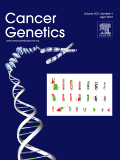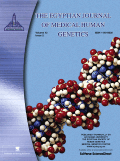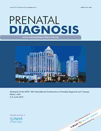
Molecular Cytogenetics
Scope & Guideline
Exploring the Intricacies of Cellular and Genetic Interactions.
Introduction
Aims and Scopes
- Prenatal and Perinatal Genetics:
The journal extensively covers research on prenatal diagnosis, including non-invasive prenatal testing (NIPT) and its implications for detecting chromosomal abnormalities in fetuses. - Cancer Genomics and Cytogenetics:
There is a significant focus on the cytogenomic characterization of various cancers, exploring chromosomal abnormalities and their prognostic implications in hematological malignancies and solid tumors. - Clinical Case Studies and Reports:
The journal publishes numerous case reports that detail unique cytogenetic findings and their clinical significance, providing insights into rare genetic disorders. - Technological Advancements in Cytogenetics:
Research on novel molecular cytogenetic techniques, such as chromosomal microarray analysis and optical genome mapping, is frequently featured, highlighting their applications in clinical settings. - Genotype-Phenotype Correlations:
The journal emphasizes studies that connect specific chromosomal abnormalities with clinical features, aiding in understanding the phenotypic manifestations of genetic disorders.
Trending and Emerging
- Non-Invasive Prenatal Testing (NIPT):
NIPT is increasingly prominent, with numerous studies exploring its efficacy and clinical implications for prenatal diagnosis, reflecting its growing acceptance in clinical practice. - Complex Genomic Rearrangements:
There is a notable trend towards investigating complex genomic rearrangements, particularly in the context of cancer and genetic disorders, signaling a deeper exploration of chromosomal instability. - Mosaicism and Uniparental Disomy:
Research on mosaicism and uniparental disomy is gaining attention, with an emphasis on their clinical significance and implications for prenatal diagnostics. - Integration of Genomic Technologies:
The journal is increasingly featuring studies that integrate various genomic technologies, such as SNP arrays and whole-genome sequencing, to enhance diagnostic accuracy and understanding of genetic conditions. - Cohort Studies in Specific Populations:
There is a growing focus on cohort studies that investigate genetic conditions within specific populations, providing valuable insights into population-specific genetic disorders.
Declining or Waning
- Traditional Karyotyping:
There seems to be a waning interest in classical karyotyping techniques as newer, more precise molecular methods gain traction in clinical diagnostics. - General Cytogenetic Techniques:
The frequency of publications solely focused on standard cytogenetic techniques, without molecular advancements, has decreased, indicating a shift towards more integrated approaches. - Broad Population Studies:
Research focusing on broad population-based cytogenetic studies, without specific clinical applications or technological advancements, appears to be less common in recent issues.
Similar Journals

Leukemia Research Reports
Innovating solutions for leukemia challenges.Leukemia Research Reports, published by Elsevier Advanced Technology, is a prominent open-access journal dedicated to the latest advancements in the field of hematology and oncology. Since its launch in 2012, this journal has been a vital resource for researchers, healthcare professionals, and students aiming to disseminate and access high-quality research articles focused on various aspects of leukemia and related blood disorders. With an impact factor indicative of its significance in the field, Leukemia Research Reports currently holds a Q3 quartile ranking in both Hematology and Oncology, and is included in key databases such as Scopus. The journal not only embraces a commitment to open access, ensuring that research is freely available, but also actively promotes collaborations that strive to enhance our understanding and treatment of leukemia. Based in the United Kingdom, this journal continues to play a crucial role in fostering innovation and knowledge sharing within the medical community.

Journal of Hematopathology
Empowering the next generation of hematopathologists.The Journal of Hematopathology, published by SPRINGER HEIDELBERG, serves as a vital resource in the fields of hematology, histology, and pathology. Established in 2008, this peer-reviewed journal aims to foster the exchange of knowledge among researchers, clinicians, and students by publishing original articles, reviews, and case studies that contribute to the understanding of hematopathological disorders. While the journal currently ranks in the fourth quartile in various categories including hematology and histology, it positions itself as a platform for emergent research and insights, addressing the evolving landscape of blood-related diseases. Although not an open access journal, it provides crucial access to research findings for professionals looking to stay abreast of developments in pathologic diagnostics and therapeutic strategies. As it continues to grow, the journal remains committed to enhancing the knowledge base and scientific discourse in hematopathology.

CYTOLOGIA
Fostering Innovation in Biological ResearchCYTOLOGIA is a prominent academic journal published by University of Tokyo Cytologia, specializing in the fields of Animal Science, Plant Science, Cell Biology, and Genetics. With origins dating back to 1929, this journal has been at the forefront of cytological research and continues to contribute to advancements in both basic and applied sciences. As of 2023, it holds a respectable position in various Scopus categories, with a Q3 ranking in Animal Science and Zoology and Plant Science, alongside Q4 rankings in Genetics and Cell Biology, reflecting its dedication to quality research dissemination. While currently not an Open Access journal, CYTOLOGIA provides critical insights and findings that are pivotal for researchers, professionals, and students aiming to further their understanding of cytology and its applications in diverse biological fields. With a historical legacy and ongoing relevance, CYTOLOGIA remains a vital resource for anyone engaged in cutting-edge research or seeking comprehensive knowledge in the biological sciences.

Global Medical Genetics
Connecting Genetics to Personalized MedicineGlobal Medical Genetics is a premier open-access journal dedicated to advancing the field of medical genetics. Published by GEORG THIEME VERLAG KG, this journal has been providing a dynamic platform for disseminating cutting-edge research and clinical findings since its inception in 2020. With the ISSN 2699-9404, it serves as an essential resource for researchers, healthcare professionals, and students who seek to explore the complex interplay between genetics and medicine. The journal aims to foster collaboration and innovation in the genetics community, addressing a diverse range of topics from genetic disorders to the application of genomics in personalized medicine. By providing open access to its content, Global Medical Genetics enhances knowledge sharing and accelerates advancements in healthcare, making it a vital asset for anyone invested in the future of genetics.

Cancer Genetics
Connecting Genetics to Cancer: A Pathway to ProgressCancer Genetics is an esteemed peer-reviewed journal dedicated to advancing the field of cancer research through the lens of genetics. Published by Elsevier Science Inc and available in both print (ISSN: 2210-7762) and online (E-ISSN: 2210-7770), this journal aims to provide a platform for the dissemination of high-quality studies that unravel the genetic underpinnings of cancer. Since its inception in 2011, Cancer Genetics has become a significant resource for researchers, professionals, and students with a shared interest in understanding the intricate relationship between genetics and oncogenesis. With an impact factor that reflects its influence, the journal has maintained a Q3 ranking in Cancer Research, Genetics, and Molecular Biology as of 2023, indicating its growing importance in these fields. Additionally, the journal offers open access options to ensure that crucial findings are easily accessible to the global research community. By bridging the gap between genetics and cancer studies, Cancer Genetics plays a pivotal role in fostering innovation and collaboration among scientists and clinicians striving to improve cancer diagnosis and treatment.

Molecular Genetics & Genomic Medicine
Pioneering research for a healthier tomorrow.Molecular Genetics & Genomic Medicine, published by WILEY, is an esteemed and open-access journal that has been a prominent source of knowledge in the fields of genetics and molecular biology since its establishment in 2013. With an ISSN of 2324-9269, it aims to provide a platform for the dissemination of novel findings and innovative research that pushes the boundaries of genomics and its clinical applications. The journal holds a Q3 categorization in Genetics, Clinical Genetics, and Molecular Biology, reflecting its growing influence in these disciplines, as evidenced by its Scopus rankings. Researchers, professionals, and students alike will find valuable insights and advancements in genomic medicine, making this journal an essential resource for those dedicated to the understanding and application of genetic and molecular research in healthcare. Located at 111 River St, Hoboken, NJ, Molecular Genetics & Genomic Medicine continues to foster a global dialogue within the scientific community, ensuring accessible knowledge for all.

Cold Spring Harbor Molecular Case Studies
Unveiling the complexities of molecular case studies.Cold Spring Harbor Molecular Case Studies is a prestigious journal published by COLD SPRING HARBOR LAB PRESS, PUBLICATIONS DEPT, that has garnered considerable attention in the fields of Biochemistry, Genetics, and Molecular Medicine. With a focus on the intersection of molecular biology and clinical case studies, this journal serves as a key resource for researchers and practitioners seeking to explore novel insights into genetic disorders and biomedical advances. Its impact is underscored by its categorization in Q2 in various disciplines in 2023, reflecting its significance and influence within the academic community. Although currently not labeled as Open Access, Cold Spring Harbor Molecular Case Studies provides a rigorous platform for disseminating high-quality, peer-reviewed research that drives innovation and enhances understanding in these rapidly evolving fields. As a supporter of advancing scientific knowledge, this journal is essential for those dedicated to the exploration of molecular mechanisms and their clinical implications.

CLINICAL DYSMORPHOLOGY
Pioneering insights into pediatric health and dysmorphology.CLINICAL DYSMORPHOLOGY, published by Lippincott Williams & Wilkins, is a pivotal journal in the fields of anatomy, genetics, and pediatric health, with a significant focus on the study of congenital disorders and their phenotypic manifestations. Established in 1992, this esteemed journal has contributed valuable insights into the understanding of dysmorphic syndromes and their clinical implications, making it an essential resource for researchers, clinicians, and students alike. With an impact factor indicative of its robust scholarly influence, CLINICAL DYSMORPHOLOGY engages a diverse readership through specialized articles, case studies, and reviews that advance the knowledge of genetic conditions and associated anatomical anomalies. Although it operates under a non-open access model, the journal is highly regarded with a 2023 ranking of Q3 in Anatomy and Q4 in several other relevant categories, reflecting its ongoing commitment to quality research in the domain of clinical medicine. Researchers and professionals are encouraged to contribute to and explore the rich content of this journal as it continues to shape the discourse in dysmorphology and related fields until its expected convergence in 2024.

Egyptian Journal of Medical Human Genetics
Innovating genetic research for better healthcare solutions.The Egyptian Journal of Medical Human Genetics is a distinguished Open Access journal published by SPRINGER NATURE, dedicated to advancing the field of medical human genetics. With an ISSN of 1110-8630 and an E-ISSN of 2090-2441, this journal serves as a vital platform for researchers, professionals, and students who are committed to the exploration of genetic implications on human health. Since its inception in 2010, it has become a growing repository of knowledge, significantly contributing to the discourse in clinical genetics, despite currently being ranked in the Q4 quartile of its category in 2023. The journal embraces an open access model, ensuring widespread visibility and accessibility of published research, thereby fostering collaboration and innovation in the field. The journal is not only aimed at disseminating findings but also at encouraging the dialogue around genetic research developments, making it an essential resource for anyone interested in the nuances of genetics and its impact on medicine.

PRENATAL DIAGNOSIS
Shaping the Future of Prenatal Care Through ResearchPRENATAL DIAGNOSIS is an esteemed journal dedicated to the fields of genetics and obstetrics, published by Wiley. With an ISSN of 0197-3851 and E-ISSN of 1097-0223, this journal has been a leading platform for the dissemination of pioneering research since its inception in 1980. Operating from its base in the United Kingdom, PRENATAL DIAGNOSIS has achieved notable recognition, attaining a Q2 category in Genetics (Clinical) and a prestigious Q1 category in Obstetrics and Gynecology as of 2023. It ranks 41st out of 209 in Obstetrics and Gynecology and 40th out of 99 in Clinical Genetics according to Scopus, placing it in the 80th and 60th percentiles, respectively. This journal provides a critical resource for researchers, healthcare professionals, and students who are focused on advancing the science of prenatal diagnosis and its application in clinical practice. While not an open access journal, the content is pivotal for those aiming to engage with the most current findings and methodologies in prenatal care. As it looks toward 2024 and beyond, PRENATAL DIAGNOSIS continues to strive for excellence in fostering breakthroughs that impact maternal and fetal health.